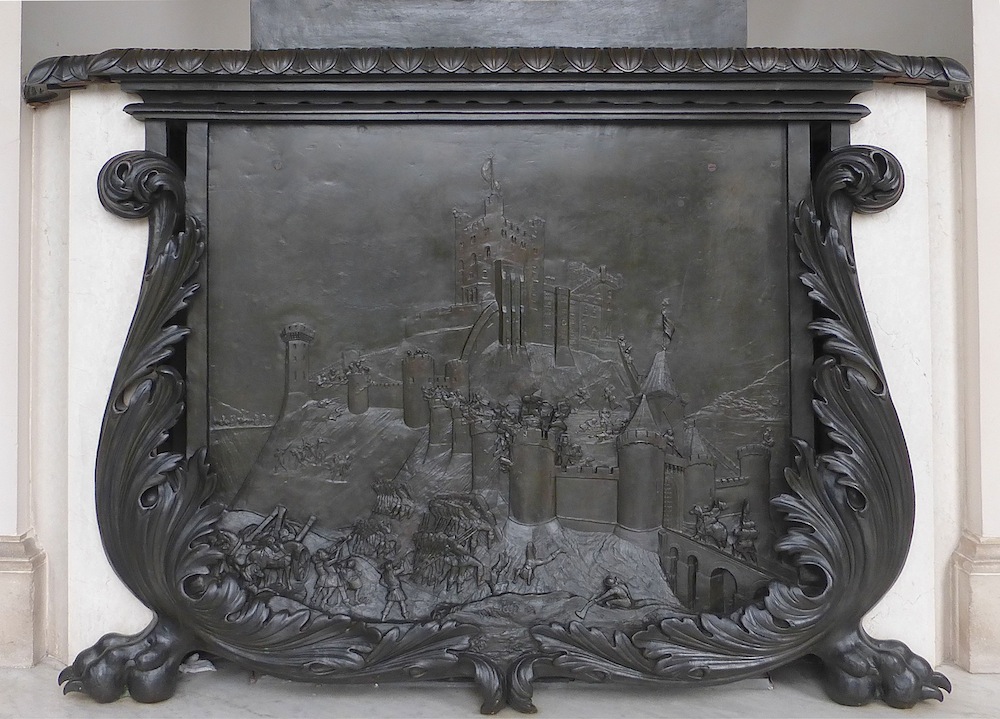Photographs by the author. Many thanks to the National Trust at Kingston Lacy for permitting me to reproduce them here, and to Tricia and Iain Frew for arranging the visit to the house and making it so enjoyable. [Click on the images to produce larger pictures.]

Close-up of upper part of Marochetti's statue of Charles I.


Left: Whole staue. Right: Close-up of pedestal with relief.
Apart from the immediate relevance to family history, William John Bankes had wanted to introduce fine artworks, including sculpture, to his remodelled house. Marochetti was the ideal choice of sculptor for a patron of decidedly European taste, and in addition to that the Frenchman had a history of supporting the monarchy, and not simply in France. Bankes had met him "some time before 31 May 1939" (Ward-Jackson 268), when he was being patronised by Louis Philippe, the last King of the French, and was known also for his statue of Emanuele Filiberto of Savoy in Turin — a work which bore testimony to Marochetti's Italian origins, and had been displayed in the courtyard of the Louvre only two years before. Bankes had already helped Marochetti to the commission for the equestrian Wellington statue in Glasgow, demonstrating his opposition to parochialism in art. It was not a popular stance, but Bankes had clearly found the right sculptor for his own major project. The contract was finally signed in 1853. It is a detailed document, given in full in an appendix to Philip Ward-Jackson's thoroughly researched and documented article on Marochetti's "expiatory monuments" in Dorset and the Isle of Wight (278-80).
The statue itself is a very fine depiction of the king, seated and dressed for riding, and wearing his tall spurred riding boots (the contract goes into some detail about all this, see p. 279). Looking towards his right, he holds his gloves in one hand and his feathered hat in the other, next to his sword, which is laxly held at the hilt. Every detail, from his elaborate lace collar to his sash, to the very fabric of his chair and its fringes, is perfectly rendered, with Marochetti's usual skill. But the most remarkable quality is the expression of noble resignation in both face and form. John Evelyn, a Royalist like Sir John Bankes, had seen Charles I's death as a "martyrdom ... execrable wickedness" (II: 8)
As with the other two statues here, the lower part of the whole monument was to hide a radiator — sculptors are often required to take into account such practical considerations. While the other two pedestals bear the Bankes's coats of arms, this one bears a remarkably detailed relief of the last siege Corfe Castle, in which Lady Mary Bankes had proved her mettle. In its depiction of the battlement tower and many turrets of the grand castle, this provides a unique and poignant record of what the family lost, as well as how stoutly they had resisted the loss.
It was while the statues of Sir John and Lady Mary Bankes were still in progress that Marochetti received another and closely related commission from Queen Victoria to execute the monument to Charles I's daughter, Princess Elizabeth, for the new St Thomas's church in Newport on the Isle of Wight. This would be installed in 1856. In addition to his own aim to pay tribute to his ancestors and their loyalty to the throne, and his ambition to make his house a centre of excellence for artwork, William Bankes does seem to have contributed to the Victorian boom in statuary. It could also be said that he was demonstrating his own support of the monarchy at a time when its safety was sometimes in doubt.
Related Material
- Statue and busts of Sir John Bankes
- Statue of Lady Mary Bankes
- Kingston Lacy
- Monument to Princess Elizabeth Stuart
Bibliography
Evelyn, John. The Diary of John Evelyn. 3 volumes. Rpt. London: Routledge / Thoemmes Press, 1906.
"Kingston Hall — Sketch of Hall and Loggia Paving." The Bankes Archive. Web. 18 March 2018. (This shows a plan of the loggia in the lower right-hand corner).
Ward-Jackson, Philip. "Carlo Marochetti and the Glasgow Wellington Memorial." The Burlington Magazine. Vol. 132, No. 1053 (Dec. 1990): 851-862. Web. 18 March 2018.
_____. "Expiatory Monuments by Carlo Marochetti in Dorset and the Isle of Wight." Journal of the Warburg and Courtauld Institutes. Vol. 53, 1990: 266-280. Accessed via JSTOR. Web. 18 March 2018.
_____. "Tomb of Princess Elizabeth." Carlo Marochetti Catalogue online on the Fine Art Facts website. 18 March 2018.
Created 9 March 2018